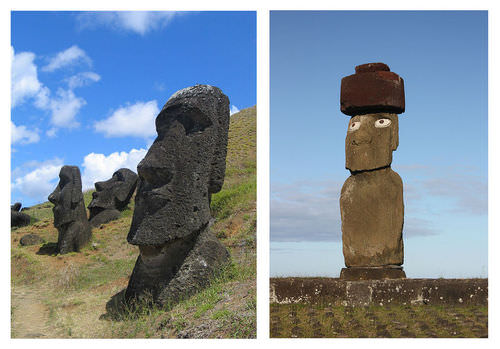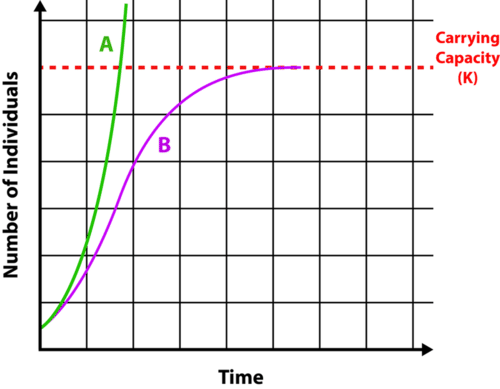早期人类人口增长 -- -- 高级
章节大纲
-
How do humans adapt to their environment?
::人类如何适应其环境?It could be said that the human does not have to adapt to its environment, but forces the environment to change to suit us. We can live practically anywhere we want, eat all types of food , and build all types of housing. Because of all of these " adaptations ," our population has grown, after a slow start, considerably fast.
::可以说,人类不必适应环境,而是迫使环境改变以适应我们。 我们可以在任何我们想要的地方生活,吃所有种类的食物,建造所有类型的住房。 由于所有这些“适应 ” , 我们的人口在缓慢的开始后增长很快。Early Human Population Growth
::人类早期人口增长Hundreds of stone figures measuring up to 10 meters tall and weighing up to 87 tons overlook a low-diversity grassland on Easter Island in the Pacific Ocean ( Figure ). The food sources, woody trees, and rope-yielding plants which helped to build and transport these statues over five hundred years ago are gone.
::数以百计的石头数字高达10米,重达87吨,忽略了太平洋复活节岛(图 ) ( Figure ) 上一个低多样性的草原。 五百多年前帮助建造和运输这些雕像的粮食来源、木质树木和产绳植物已经消失。Easter Island today is a low-diversity grassland nearly devoid of the food sources, woody trees, and rope-yielding plants which helped to build and transport these 10-meter stone statues. Jared Diamond suggests that overpopulation and overexploitation of resources led to the collapse of a once-thriving Easter Island society, and that Easter Island is “Earth writ small” – a warning to the world. Pollen analyses suggest that the island was totally forested at least until 1200 CE, but that by 1650 the forests had entirely disappeared. Middens (waste dump sites) show a sudden disappearance of sea and , suggesting that wood for canoes was no longer available. Sediments reveal that half of native plant had become extinct. Later fire pits indicate the possibility of cannibalism.
::花粉分析显示,至少到1200年,岛上的森林已经完全砍伐,但到1650年,森林已经完全消失。 密甸人(垃圾倾弃场)显示海洋突然消失,这表明独木舟的木头已经不复存在。 沉积物显示,一半的本地植物已经绝种。 后来的火坑显示了食人的可能性。Jared Diamond, in his book Collapse: How Societies Choose to Fail or Succeed, examines this bleak scene and other past societies and concludes that doomed civilizations share eight traits which contribute to their collapse. Seven of the eight traits are rooted in overpopulation relative to environmental carrying capacity . Diamond considers Easter Island to be “Earth writ small” – a warning that this island’s environmental devastation could foreshadow a similar fate for our planet. He encourages humans to learn from earlier collapses to conserve the forest, soil , , , fish, photosynthetic, atmospheric, and energy resources upon which our human lives depend. A large group of people sometimes known as “Neo-Malthusians” join Diamond in his belief that human cannot continue without dire consequences.
::贾里德·戴蒙德(Jared Diamond)在其著作《倒塌:社会如何选择失败或失败 》 中审视了这一暗淡的场景和其他过去的社会,并得出结论说,注定的文明有着导致其崩溃的八种特征。 这八种特征中有七种根源于相对于环境承载能力而言人口过多。 钻石认为复活节岛是“地势小 ” — —警告说这个岛屿的环境破坏可能预示着我们星球的类似命运。 他鼓励人类从早期的崩溃中学习如何保护我们人类赖以生存的森林、土壤、 — — 水、鱼、光合、大气和能源资源。 有时被称为“Neo-Malthusians ” 的一大批人加入了钻石的行列,认为人类不可能在没有可怕后果的情况下继续生存下去。Julian Simon and a group dubbed “cornucopians” see the human condition differently. Named for the mythical Greek "horn of plenty” which supplied endless food and drink magically, cornucopians believe that the Earth can provide an almost limitless abundance of natural resources , that few natural limits to growth exist, and that technology can solve or overcome population-induced resource scarcity and environmental degradation. Larger human population (within an appropriate political environment) is the answer to the problems of population growth, according to Simon.
::朱利安·西蒙(Julian Simon)和一个被称为“独角兽”的团体(Cornucopians)对人的状况的看法不同。 希腊神话中的“富人之角 ” ( horn of mounty ) , 提供无尽的食品和无尽的饮料。 玉米人相信地球可以提供几乎无限的自然资源,对增长的自然限制很少,技术可以解决或克服人口引起的资源稀缺和环境退化。 西蒙认为,更多的人口(在适当的政治环境中)是解决人口增长问题的答案。Are you, like Diamond and Malthus before him, a “doomster”? Or do you join Simon as a “boomster”? Most “doomsters” and “boomsters” share the belief that we are responsible for managing problems related to population growth. Let’s use our understanding of population biology to study the human population. Our goal will be to shed light on the decisions we – the only species able to consider and alter our rates of birth and death – make about future population growth.
::像戴蒙德和马尔萨斯(Malthus)之前的你一样,你是“放大者 ” ? 还是你加入西蒙(Simon)为“放大者 ” ? 多数“放大者 ” 和“放大者 ” 都认为我们有责任管理与人口增长有关的问题。 让我们利用我们对人口生物学的理解来研究人类人口。 我们的目标是揭示我们这个唯一能够考虑和改变我们出生和死亡率的物种对未来人口增长做出的决定。The past two lessons have shown how populations in nature grow. You have learned that all populations have the potential to grow exponentially ( exponential (J-curve) growth ), but that exponential growth is limited to ideal conditions, which are rare in nature. In nature, for limited resources or unpredictable, density-independent limiting factors restrict populations to densities at or below carrying capacities (S-curve growth pattern). Some populations grow smoothly to a stable carrying capacity, but others overshoot that density and may crash before rebuilding to a relatively stable level. A few crash to extinction . In unstable environments, some populations establish cycles of population growth and decline. Unstable environments favor adaptations for rapid growth ( r-selected species ), and stable environments favor adaptations for efficient use of resources ( K-selected species ).
::过去的两个教训显示了自然人口是如何增长的。你已经了解到,所有人口都有指数增长的潜力(快速(J-曲线)增长),但指数增长仅限于理想条件,而这种条件在自然中是罕见的。 在自然中,对于有限的资源或无法预测的,依赖密度的限制性因素将人口限制在承载能力或低于承载能力的密度(S-曲线增长模式 ) 。有些人口增长顺利,达到稳定的承载能力,但另一些人口超过了密度,在重建到相对稳定的水平之前可能崩溃。少数人口崩溃而濒临灭绝。在不稳定的环境中,一些人口形成人口增长和衰退的周期。 不稳定的环境有利于快速增长的适应性(亲选物种 ) , 稳定的环境有利于资源高效利用的适应性(K-选择物种 ) 。Where do humans fit? Are we built for growth – or conditioned for efficient use of resources? Does our growth pattern resemble a J, or an S? Are we in danger of extinction? What exactly is our “population problem,” and what can we do to solve it?
::人类适合哪里? 我们是为增长而建,还是为有效利用资源而建? 我们的增长模式像J还是S? 我们是否面临灭绝的危险? 我们的“人口问题”究竟是什么? 我们怎样才能解决这个问题?Early Population Growth
::早期人口增长The growth of the world’s human population (using estimates by scholars in the field for the time before census data) shows a classic J shape on this 12,000-year scale. Can you distinguish the decline due to “black death” in the early middle ages? Growth of populations according to Malthus’ exponential model (A) and Verhulst’s logistic model (B). Both models assume that population growth is proportional to population size, but the logistic model also assumes that growth depends on available resources. A model's growth under ideal conditions shows that all populations have a capacity to grow infinitely large. B limits exponential growth to low densities; at higher densities, competition for resources or other limiting factors inevitably cause growth rate to slow to zero. At that point, the population reaches a stable plateau, or the carrying capacity. Let’s begin by looking at the data. Worldwide human population from 10,000 BCE through today is graphed in the Figure . The theoretical J (exponential) and S (logistic) growth curves are reviewed in the Figure . Overall, our growth resembles exponential growth (the J curve), increasing very slowly at first, but later growing at accelerating rates which show no sign of nearing carrying capacity. We appear to be r -selected for rapid growth; indeed, some have described humans as the most successful “ weed species” Earth has ever seen as we are fast growing, rapidly dispersing, and colonize habitats from pole to pole. If Earth has a carrying capacity for humans, it is not yet visible in our growth curve – at least on this scale.
::让我们从观察数据开始。从10 000个生物计算中心到今天的世界人口在图中图表列出。理论J(特效)和S(物流)增长曲线在图中审视。总体而言,我们的增长类似于指数增长(J曲线 ) , 最初增长非常缓慢,但后来却以没有接近承载能力迹象的加速速度增长。 我们似乎被选为快速增长的r;事实上,有些人将人类描述为最成功的“杂草物种 ” , 因为我们正在快速增长、迅速分散和从极到极的殖民栖息地。 如果地球具有载人的能力,那么在我们的增长曲线中 — — 至少在这种规模上 — — 还没有显现出来。However, closer study of human population dynamics reveals more complexity. Different countries show different patterns of population growth today, and history shows varying patterns of growth across time. The history of human population growth can be divided into four stages. Today’s countries show snapshot views of these stages. In this section, we will look at early human population growth.
::然而,更仔细地研究人类人口动态揭示了更复杂的问题。 不同国家今天的人口增长模式不同,历史也不同。 人类人口增长的历史可以分为四个阶段。 今天的国家对这些阶段的简要看法。 在本节中,我们将审视早期的人类人口增长。As scientists currently understand human history, Homo sapiens arose about 200,000 years ago in Africa. Living as nomadic hunter-gatherers, we migrated to Eurasia and Australia about 40,000 years ago and into the Americas 30,000 years later. Throughout this period, both birth rates and death rates were probably high – as much as 5%. Our human population grew slowly as we spread throughout the world, out-competing other hominid species with our apparently superior reproductive and competitive adaptations. Ice ages, warming periods, and volcanic eruptions were density-independent factors which severely limited our population growth. For example, a “supervolcanic” eruption at Toba in Sumatra 74,000 years ago covered India and Pakistan with more than 5 feet of ash, causing 6 years of nuclear winter, a thousand-year ice age, and the death of up to 99% of the humans living at the time!
::科学家们目前了解人类历史,非洲20万年前就出现了智人。 作为游牧狩猎采集者,我们于40,000年前移民到欧亚和澳大利亚,并在30,000年后移民到美洲。 在整个这段时期,出生率和死亡率可能都很高 — — 高达5 % 。 我们的人口增长缓慢,随着我们在世界各地的蔓延,其他有色人种与我们表面上优越的生殖和竞争适应相悖。 冰河时代、变暖期和火山爆发是依赖密度的因素,严重限制了我们的人口增长。 比如,74,000年前苏门答腊的托巴“超火山”爆发覆盖了印度和巴基斯坦5英尺以上的火山灰,导致6年的核冬天、1000年的冰龄,以及当时多达99%的人类死亡!With the invention of 10,000 years ago, we began to develop settled civilizations and trade. Disease associated with animal domestication and city living increased death rates, but reliable food supplies, shared childcare, and division of labor increased birth rates. These effects may have offset each other; slow and uneven growth probably continued. However, the of agriculture, like many advances in technology, almost certainly raised carrying capacity.
::随着一万年前的发明,我们开始发展定居的文明和贸易。 与动物饲养和城市生活有关的疾病增加了死亡率,但可靠的食品供应、共同的儿童保育和劳动分工却增加了出生率。 这些效应可能相互抵消;增长缓慢和不平衡可能还会继续。 然而,农业与许多技术进步一样,几乎肯定提高了承载能力。Beginning about 6000 years ago, political states evolved, cooperated or competed, and sometimes waged war. Empires formed, connecting previously independent populations. In the Middle Ages, technology advanced, and the 17 th century brought the Scientific Revolution. Throughout this long period of human history, death rates and birth rates continued to be high. Density-independent factors such as drought and the “little ice age” combined with density-dependent factors such as disease to keep death rates high and variable. The “black death” of the mid-fourteenth century killed as many as 75 million people worldwide and the disease is one of the very few events whose effects are visible in any graph of human population growth ( Figures , ). Birth rates continued at a high level throughout early human history. Carrying capacity rose with major advances in technology, as humans modified the environment by irrigating land, building cities, and transporting animals, plants, and products. The overall result was slow growth and a young population. By 1804 CE, the world’s human population had reached 1 billion.
::从大约6000年前开始,政治国家演变、合作或竞争,有时还爆发战争。帝国形成,连接了以前独立的人口。在中世纪,技术进步和17世纪带来了科学革命。在这漫长的人类历史时期,死亡率和出生率仍然居高不下。干旱和“小冰河时代”等依赖密度的因素加上诸如疾病等依赖密度的因素,使死亡率保持高和可变性。 14世纪中叶的“黑死”使全世界多达7500万人死亡,而这一疾病是人类人口增长的任何图表(图表 ) 所显示的极少数事件之一。 出生率在整个人类早期历史上一直保持在高水平上。 随着技术的重大进步,随着人类通过灌溉土地、建设城市、运输动物、植物和产品来改变环境,能力不断上升。 其总体结果是缓慢的增长和年轻人口。 到1804年,世界人类人口已经达到10亿。Early human populations showed slow, uneven growth. At this scale, the negative effect of increased death rate due to the “black plague” during the mid-fourteenth century is clear. Summary
::摘要-
According to Neo-Malthusians, the worldwide human population may have already passed Earth’s carrying capacity in terms of environmental degradation, resource depletion, and unbalanced distribution of food, wealth, and development. More people will increase the danger of famine or war.
::根据新马尔图斯人的说法,全世界人类人口在环境退化、资源枯竭和粮食、财富和发展分配不平衡方面可能已经超越了地球的承载能力。 更多的人将增加饥荒或战争的危险。 -
According to the cornucopians, technology and innovation can solve any problems which arise due to human population growth. The more people, the better.
::根据大主教的说法,技术和创新可以解决人类人口增长引起的任何问题。 人越多越好。
Review
::回顾-
Describe the overall pattern of human population growth, beginning with our origins, and compare it to the exponential and logistic models.
::描述人类人口增长的总体格局,从我们的起源开始,并与指数模型和后勤模型进行比较。 -
Compare Neo-Malthusians and cornucopians.
::比较新马尔图斯人 和角印人。 -
Discuss the factors that influenced human population growth up to the first 1 billion mark.
::讨论影响人口增长直至前10亿大关的各种因素。
-
According to Neo-Malthusians, the worldwide human population may have already passed Earth’s carrying capacity in terms of environmental degradation, resource depletion, and unbalanced distribution of food, wealth, and development. More people will increase the danger of famine or war.




